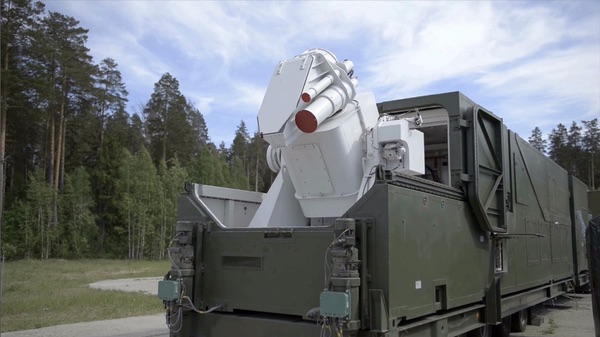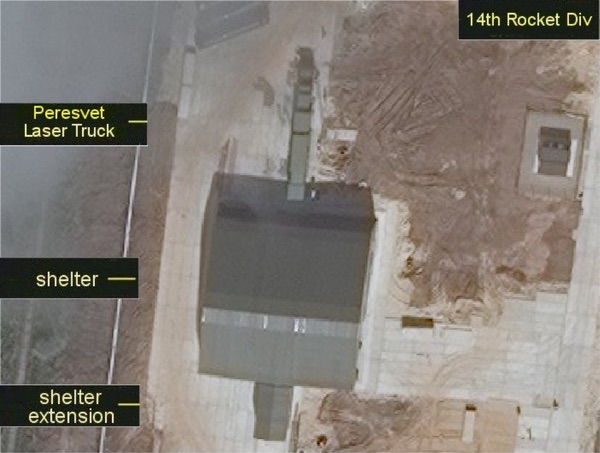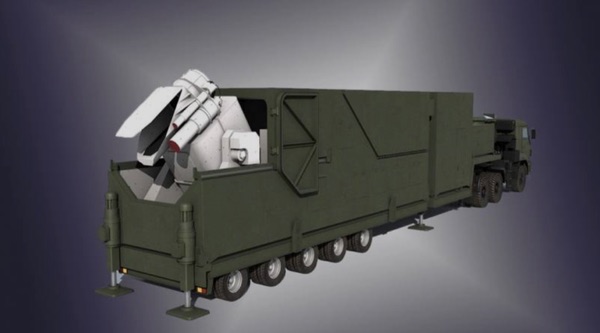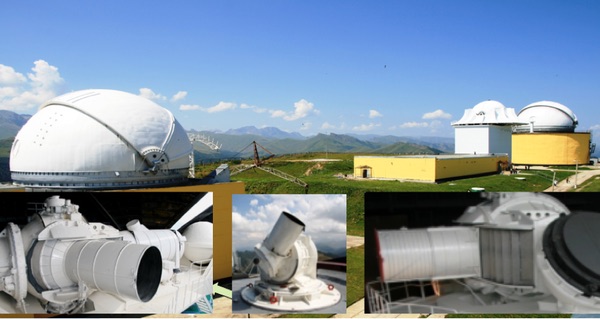
One of the first images revealed of the Peresvet laser system
A meticulously researched article recently appeared at The Space Review, documenting and dissecting the project history and likely capabilities of a new Russian laser system. The analysis concludes that the Peresvet laser complex unveiled by President Putin in March 2018 has an anti-satellite role, and that the system is intended to conceal the movements of road-mobile ICBMs by temporarily dazzling or permanently blinding optical systems of enemy reconnaissance satellites.
While the study’s primary focus is the ground-based, mobile Peresvet laser system, it also reviews available information – from a quite staggering variety of sources ranging from almost twenty years of defence procurement tenders and contracts to bank documents – concerning similar stationary and airborne systems with similar capabilities. The author is suitably impressed by Russia’s achievements in the field, remarking that:
Whatever the rationale for having at least three separate satellite dazzling/blinding systems, Russia clearly has a major interest in this type of directed energy counterspace technology, which has the advantage that it produces no space debris and may make it hard for the adversary to prove that its satellites have been affected or damaged as the result of a hostile act. The country also seems to have invested in both ground-based and space-based electronic warfare systems against satellites, another type of non-destructive counterspace technology. Still, all this has not stopped Russia from also developing more conventional kinetic ASAT weapons like the ground-launched Nudol and the air-launched Burevestnik systems.
Based on currently available information, it appears that the anti-satellite capabilities being developed by Russia are unmatched by any other nation (or collective of nations, such as NATO), and has likely been motivated by the US’ growing fleet of military satellites in particular. They are probably at least part of the reason why Russian President Vladimir Putin recently commented that he is not particularly concerned by the US’ determination to develop and deploy hypersonic weapons as soon as possible.
In his State of the Union address in 2018 Putin announced the development of advanced weapons systems including nuclear powered cruise missiles and hypersonic glide vehicles capable of penetrating US missile defence systems, and he also remarked that some laser weapons had already been deployed by the Russian Armed Forces, though he declined to provide further details.
The article posted by The Space Review elaborates at considerable depth on several of these projects. With respect to the Peresvet system, it was revealed in a brief video accompanying Putin’s statements showing a laser mounted on a semi-trailer. Later in 2018 the Ministry of Defence published another video featuring the Peresvet laser systems and stating that they were undergoing final preparations to enter combat duty. From the brief footage of the shelters where they were located, by matching them with satellite imagery researchers managed to pinpoint several of their locations:
The shelters were located at bases of the Strategic Missile Forces operating road-mobile intercontinental ballistic missiles. More specifically, the shelters were seen at ICBM garrisons near Teykovo, Yoshkar-Ola, and Novosbirsk, with some of the imagery showing Peresvet laser trucks parked outside.
All of these bases are armed with the mobile Yars ICBMs, a three-stage solid fuel missile equipped with independently targetable warheads and with a range of up to 12,000km.

Satellite image of a Peresvet laser system located outside its shelter
The author notes that:
The discovery that the laser trucks were based at ICBM sites made it possible to narrow down the possible objectives of Peresvet. Most analysts agreed that it was probably not powerful enough to physically destroy targets, but was designed to damage optical systems of vehicles trying to attack or image mobile ICBMs: aircraft, drones, cruise missiles, or satellites. The latter were considered by many to be the most likely targets for Peresvet.
The conjecture that the primary purpose of the Peresvet laser system is to temporarily disable satellites is corroborated by an exhaustive examination of related documentation, including registered patents, defence contracts, corporate annual reports and bank documents. Finally:
In December 2018, the Russian Ministry of Defense released another video of the trailer-mounted laser system on Facebook. The accompanying statement said that Peresvet had entered “experimental combat duty” and could “efficiently counter any aerial attack and even fight satellites in orbit,” which was the first official acknowledgment that Peresvet has an ASAT capability. The information was removed less than an hour after it appeared online, suggesting it was released by accident. Late last year, the Chief of the General Staff of Russia’s Armed Forces Valeriy Gerasimov confirmed that Peresvet’s task is to “conceal the movements” of mobile missile systems.[8] Defense Minister Sergei Shoigu announced somewhat later that Peresvet had been declared operational at five missile divisions on December 1, 2019.
The Peresvet laser system is mounted on a KAMAZ-65225 tractor unit and a ChMZAP-99903 semi-trailer carrying several containers. These units are called the technological container, environmental control container, equipment container, and support container. The laser and its telescope are mounted in the aft container (likely the “equipment container”), which has a sliding roof. The videos also show several support vehicles accompanying the laser truck, at least one of which is used as a command post and another to supply power to the laser.

KAMAZ tractor unit used to deploy the Peresvet laser system
The author identifies four of the deployed laser systems’ ground support facilities from a review of contracts signed by the Ministry of Defence: the 54th Missile Division near Teykovo, the 39th Missile Division near Novosibirsk, the 35th Missile Division near Barnaul, and the 14th Missile Division near Yoshkar-Ola.
Last December Russian Deputy Defence Minister Aleksey Krivoruchko said that it is expected that the Peresvet system will be adapted so that it can be deployed on ‘an airborne carrier’. Russia has been working on another system airborne laser system since 2002, called Sokol-Eshelon, which is also thought to have ASAT capabilities and is carried on a modified Ilyushin-76MD transport aircraft.
One of the project’s designers stated that laser system was intended to “counter air-based and space-based reconnaissance assets in the infrared part of the spectrum,” an apparent reference to dazzling and/or blinding reconnaissance and guidance systems rather than being designed to destroy specific targets. This requires lasers with much lower energy and is therefore less expensive and complex. The type of laser selected for Sokol-Eshelon was a carbon monoxide laser.
Airborne laser ASAT systems are generally more flexible in the choice of targets and are less susceptible to adverse atmospheric conditions. The current state of the project is unknown, and the author concludes that there is no connection between it and the Peresvet project, and raises the possibility that one of the systems may be intended as an anti-aircraft weapon, or even as a defence against enemy missiles.
In addition to the mobile and airborne variants, Russia has been developing a stationary ground-based capability to dazzle or blind satellite sensors at an optical/laser space surveillance facility in the North Caucasus. The Kalina facility is located at the Krona complex, situated on the Chapal mountain near Storozhevaya, consists of a radar installation to identify satellites and categorize them. Other documents related to the site however refer to it as a ‘space security complex’ and mention that it is involved in the development of ‘laser systems for electro-optical warfare’, strongly suggesting it also has an ASAT role.
The current status of Kalina is unknown. Sokol-Eshelon and Kalina are clearly not point-defence systems like Peresvet, indicating their primary task may be blinding (that is, permanently disabling) rather than dazzling satellites.
MORE ON THE TOPIC:







Makes sense.
Now it’s time to test it on non carbon forms of life. :)
What non carbon life forms are those that you’d like to see it tested on?
I don’t know. It was a joke. Maybe it was a stupid joke.
Good job Comrades.
CIA trolls and hasbarats will cry and rage :)
Ukropnazis too…
This is basically Tesla tech, combined with Magrav-tech and hypersonic weapons Russia doesn’t even have to use nukes.
Glory to Mother Russia.?
I believe the part about ground based systems but space based lasers, what evidence is there for space based lasers other than to justify ‘Space Force’?
The ground based systems look large as they require a power source, a space (or air based) system would need to be shrinked, would it not. I would also think that they would want either a nuclear or solar based power cell for a space based weapon.